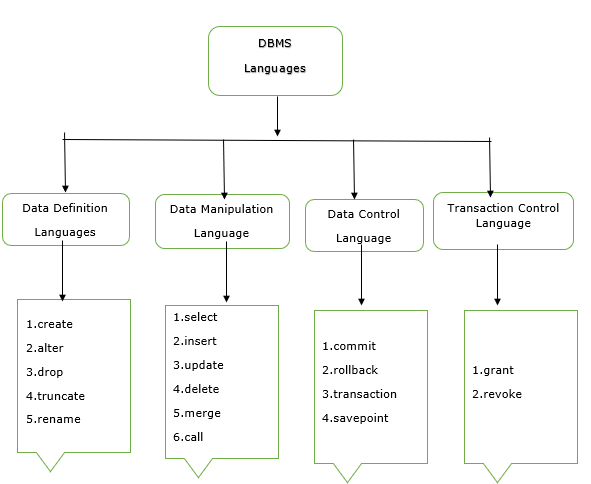
 Data Structure
Data Structure Networking
Networking RDBMS
RDBMS Operating System
Operating System Java
Java MS Excel
MS Excel iOS
iOS HTML
HTML CSS
CSS Android
Android Python
Python C Programming
C Programming C++
C++ C#
C# MongoDB
MongoDB MySQL
MySQL Javascript
Javascript PHP
PHP
- Selected Reading
- UPSC IAS Exams Notes
- Developer's Best Practices
- Questions and Answers
- Effective Resume Writing
- HR Interview Questions
- Computer Glossary
- Who is Who
What are different types of DBMS languages?
Once data is stored or filled it requires manipulation like insertion, deletion, updating, and modification of data. For these operations a set of languages are provided by the database management system (DBMS). So, the database languages are used to read, update and store data in the database.
The different types of DBMS languages are as follows ?
Data Definition Language (DDL) ? Create, Drop, Truncate, Rename.
Data Manipulation language (DML) ? Select, Insert, Delete, Update.
The DBMS languages are pictorially represented as follows ?

Data Definition Language (DDL)
It is a language that allows the user to define the data and their relationship to other types of data. The DDL commands are: Create, Alter, Rename, Drop, Truncate.
Data Manipulation Language (DML)
It is a language that provides a set of operations to support the basic data manipulation operation on data held in the database. The DML commands are: Insert, delete, update, select, merge, call.
Data Control Language (DCL)
DCL is used to access the stored data. It is mainly used for revoke and grant the user access to a database. The DCL commands are: Grant, Revoke.
Transaction Control Language (TCL)
TCL is a language which manages the transactions within the database. It is used to execute the changes made by the data manipulation language statements. The TCL commands are: Commit, Rollback.

